
- Applications
-
Products
-
Liquid Handling
- firefly Accelerate genomic research with innovative all-in-one, compact liquid handling
- mosquito Nanolitre liquid handling technology performs ‘traditional’ tasks at a fraction of the volume, and higher speeds
- dragonfly Delivers accurate and repeatable nanolitre to milliliter dispensing
- apricot Automated liquid handling instrumentation for convenient general use across your entire team
- Sample Preparation
-
Sample Management
- comPOUND A scalable, reliable, and secure compound management solution
- BioMicroLab Easy-to-use sample management automation instruments
- arktic Robust biospecimen storage and management down to -80°C
- lab2lab Novel sample and data transfer network system
- comPACT Reliable and efficient -20°C storage and retrieval has never been more accessible
-
Liquid Handling
-
About
- Company With a focus on liquid handling, sample preparation and sample management, our expert teams create state-of-the-art solutions that scientists and researchers can trust Culture We have one overarching mission: to work together to accelerate life science research. Through our innovative solutions and state-of-the-art tools, we believe we can make a real difference to human health Partners Collaboration is key in our mission to make a real difference to human health. Partnering with application leaders globally, we co-create to solve new challenges across the life sciences. Innovation From the initial prototype through to manufacturing, installation and beyond, we bring a problem-solving mindset and technical expertise to drive innovation
-
Executive Leadership
 Through strategic guidance, visionary thinking, and a relentless pursuit of excellence, our senior executives steer SPT Labtech towards achieving its mission of making a real difference to human health through solving advanced laboratory challenges.
Learn more
Through strategic guidance, visionary thinking, and a relentless pursuit of excellence, our senior executives steer SPT Labtech towards achieving its mission of making a real difference to human health through solving advanced laboratory challenges.
Learn more 
-
View all
 Board of Directors
Board of Directors
 Our Board of Directors are committed to driving the long-term success and sustainability of SPT Labtech, providing expert guidance and oversight to execute the company’s ambitious commercial strategy.
Learn more
Our Board of Directors are committed to driving the long-term success and sustainability of SPT Labtech, providing expert guidance and oversight to execute the company’s ambitious commercial strategy.
Learn more 
-
Knowledge Base
- Resources Our wide range of insightful resources include videos, whitepapers, eBooks, application notes and more Events & Webinars Meet the SPT team at events all over the globe and virtually via our webinars Podcast We chat with innovators and leaders from across the community to gain their unique insights. News Latest news from SPT Labtech globally Blog Our latest blog posts feature trends in research, innovative techniques and new technology
-
14 January, 2026
.jpg?length=320&name=Twist%20x%20SPT%20Labtech%20Press%20Release%20(1200%20x%20800%20px).jpg) SPT Labtech enables automated Twist Bioscience NGS library preparation workflows on firefly platform
Continue reading
SPT Labtech enables automated Twist Bioscience NGS library preparation workflows on firefly platform
Continue reading 
-
11 December, 2025
 5 Key Sample Management Automation Trends for 2025- 2026: An Interview with SPT Labtech’s Cory Tiller
Continue reading
5 Key Sample Management Automation Trends for 2025- 2026: An Interview with SPT Labtech’s Cory Tiller
Continue reading 
-
04 December, 2025
.jpg?length=320&name=SBTi%20Target%20Announcement,%20mktg%20(1200%20x%20800%20px).jpg) Delivering Sustainable Science: SPT Labtech Validates GHG Reduction Targets to Meet Customer Needs
Continue reading
Delivering Sustainable Science: SPT Labtech Validates GHG Reduction Targets to Meet Customer Needs
Continue reading 
10
- Careers
Market-leading sample supports enable cryo-EM researchers to optimize data quality
Quantifoil Micro Tools GmbH pioneered the commercialization of perforated support films for electron microscopy with convenient predefined hole size, shape and arrangement. With more than 20 geometries on a full range of TEM grid materials and designs, the range of support foils provides high performance and flexibility to support diverse cryo-EM research needs.The growing product portfolio encompasses UltrAuFoil Holey gold supports on gold grids which, by reducing beam-induced motion, allow researchers to obtain higher quality structures of even the most challenging targets.
Quantifoil in the lab

Thanks so much! We use quantifoil grids for both our cryoEM and our in situ cryoET. They are an essential part of our workflow!
— Dr Ben Engel, Max Planck Institute of Biochemistry
Market-leading cryo-electron microscopy support grids
With more than 20 film geometries available on a full range of TEM grid materials and designs, our range of support foils provides high performance and flexibility for diverse cryo-EM research needs.
- HexAuFoil®
- UltrAuFoil®
- SiO2 Films
- QUANTIFOIL®
- Additional UltraThin Carbon Layer (UTC)
- QUANTIFOIL® Active
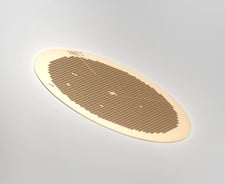
HexAuFoil®
Ultra-small hole gold supports
Improve every image with these revolutionary new small hole, holey-gold supports that enable zero-dose reconstructions for the first time by delivering movement-free imaging. Our most advanced cryo-EM support to maximise efficiency for high-resolution structure determination in drug discovery and basic research. The first pre-production batches are now available to order.
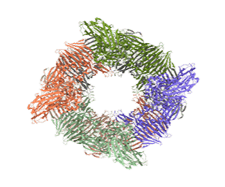
UltrAuFoil®
Ultra-stable gold supports for cryo-electron microscopy
Developed in collaboration with leading scientists, UltrAuFoil Holey Gold sample supports simplify structure determination even for challenging and small molecules. During imaging at cryogenic temperatures, traditional carbon supports move, particularly at the beginning of irradiation. This movement blurs images and reduces data quality. UltrAuFoil Holey Gold supports are more conductive, with no differential contraction between the grid and the foil on plunge freezing. This technical improvement minimizes any crinkling of the foil during sample preparation, substantially increasing data quality and efficiency.
Structure of Thermotoga maritima β-galactosidase solved using data collected on UltrAuFoil R 1.2/1.3 (Amil et al, ACS Chem Biol 15: 179-188, 2020). With thanks to Rafael Fernandez-Leiro, CNIO, Spain.
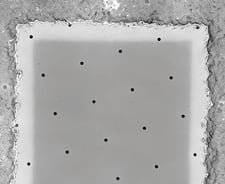
SiO2 Films
Resilient and extensively functionalizable
Extensively functionalizable, our silicon dioxide films offer a glass-like surface ideal for cell-growth. They are resilient enough to withstand the additional manual handling involved with on-grid cell growth, tomography, CLEM and cryo‑FIB.
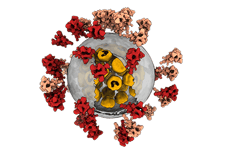
QUANTIFOIL®
QUANTIFOIL® Holey Carbon Supports for Cryo-EM
QUANTIFOIL Holey Carbon supports are a flat film of carbon, 10-12 nm thick, on a cryo-electron microscopy (cryo-EM) grid, providing a low-background sample support for high-resolution cryo-EM data collection. Researchers can choose the optimum grid for any project from a comprehensive selection of hole shapes, sizes and spacings in combination with a range of base grid materials and mesh sizes. Grid options include standard square meshes as well as other arrangements and finder grid formats.
With thanks to Prof. Sai Li, Tsinghua University, tomogram of the SARS-CoV-2 Virus from data collected using Quantifoil Carbon R 2/2 on Cu 300 mesh. As seen in Yao et al, Cell 183: 730-738 (2020).
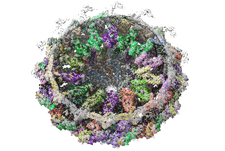
Additional UltraThin Carbon Layer (UTC)
Improvements in specimen quality
An ultrathin (2-3 nm) carbon layer further enhances particle distribution and data quality when applied to both QUANTIFOIL Holey Carbon Films and UltrAuFoil Gold Supports.
Particle density is improved due to the ready adsorption of many biomolecules onto the carbon surface prior to blotting. This additional layer may also reduce the adoption of a preferred orientation. Researchers also benefit from improved particle distribution as particles can adsorb onto the carbon across the entire hole.
Most QUANTIFOIL Holey Carbon Film supports can be supplied with an additional carbon layer on request.
Structure of Helicobacter pylori outer membrane complex from data collected on Quantifoil Carbon R 2/2 on Cu 200 mesh with a 2 nm UTC. As described in Sheedlo et al, eLife 9: e59495 (2020).
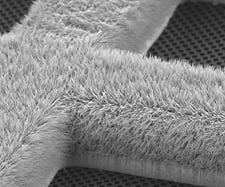
QUANTIFOIL® Active
Self-wicking grids for use exclusively with chameleon
QUANTIFOIL®️ Active grids are unique in being the first commercially produced grids with copper nano-wire covered bars to promote thin film formation through a process of “self-wicking”. This novel grid technology removes the variability of applying an externally applied filter paper to remove excess sample during blotting.

